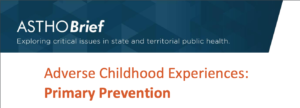ASTHO’s Brief: Primary Prevention of Adverse Childhood Experiences (ACEs)
ASTHO announced two new resources to guide violence prevention practitioners in advancing the primary prevention of adverse childhood experiences (ACEs). A brief Adverse Childhood Experiences: Primary Prevention and an upcoming ASTHOConnects webinar equips prevention practitioners and state and territorial health officials with the tools they need to advance the primary prevention of ACEs.

The brief highlights examples of primary prevention strategies, include building skills and promoting social norms for positive parenting, strengthening economic supports for families, and providing quality education and enrichment early in life. Early head start programs, dual generational approaches, increasing the minimum wage, and enhancing the state and federal Earned Income Tax Credit (EITC) are only a few examples primary prevention strategies for ACEs, and these strategies overlap with the strategies sexual and domestic violence prevention practitioners are familiar with from the STOP SV and Preventing IPV Across the Lifespan technical packages.
The ASTHOConnects Webinar: Primary Prevention of Adverse Childhood Experiences (ACEs) will discuss how states are using the Behavioral Risk Factor Surveillance System (BRFSS) module and other data sources on ACEs to inform their primary prevention work, connect ACEs with other forms of violence and adverse health outcomes, and examine intergenerational health patterns that are impacted by ACEs. Register for this ASTHOConnects webinar at this link, and read more about their featured guests and their work.
Preventing ACEs prevents sexual and intimate partner violence, too. Expanding research and recommendations on preventing ACEs creates more opportunities for sexual and domestic violence prevention to impact communities across a lifespan and across generations.
